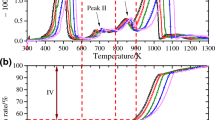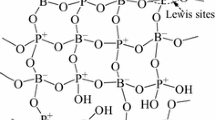Abstract
Polyurethane foam (PUR) from waste refrigerators has long been recognized as a difficult-to-treat electronic waste, due to its bulkiness, low weight and chlorofluorocarbon content. In this work, the combustion and pyrolysis behaviors of PUR were investigated using a versatile thermogravimetric–Fourier infrared spectrum–mass spectrum (TG/FT-IR/MS) technique. The decomposition mechanisms in both thermal processes were determined, and the fate of halogens was probed well. TG analysis indicated that the PUR combustion could be divided into three main stages with peak temperatures of 328, 557 and 970 °C, respectively. As a comparison, its pyrolysis could be divided into two steps with peak temperatures of 332 and 970 °C. FT-IR results indicated that the PUR combusted vigorously at 400–600 °C, whereas it decomposed drastically at the lower temperature of 200–400 °C in pyrolysis. MS analysis revealed that the urethane bonds in the PUR molecules broke into isocyanates and polyols at 200–400 °C in combustion, which further decomposed at 400–650 °C and reacted with halogens. However, the ester bonds ruptured into aromatic nitro compounds and ethers at 200 °C below in pyrolysis. At higher temperature range of 200–500 °C, more halogenated derivatives were detected with lower intensity. In addition to the halogenated products such as chlorofluorocarbons, chlorobenzene, dichlorobenzene, o-chloroaniline, and trifluoroacetone, small molecules of hydrogen cyanide, ammonia, carbon dioxide, carbon monoxide were all detected.









Similar content being viewed by others
References
Li J, Zeng X, Chen M, Ogunseitan OA, Stevels A. “Control-Alt-Delete”: rebooting solutions for the e-waste problem. Environ Sci Technol. 2015;49(12):7095–108.
Yao Z, Ling T, Sarker PK, Su W, Liu J, Wu W, Tang J. Recycling difficult-to-treat e-waste cathode-ray-tube glass as construction and building materials: a critical review. Renew Sustain Energy Rev. 2018;81:595–604.
Yu S, Su W, Wu D, Yao Z, Liu J, Tang J, Wu W. Thermal treatment of flame retardant plastics: a case study on a waste TV plastic shell sample. Sci Total Environ. 2019;675:651–7.
Conesa JA, Soler A. Decomposition kinetics of materials combining biomass and electronic waste. J Therm Anal Calorim. 2017;128(1):225–33.
Jin-Hui L. I.; Dong Q. Y.; Yao Z. T.; Liu L. L.; Environment S. O.; University T. Study on the management status and countermeasures for waste polyurethane foam from refrigerators in China. China Environ Sci. 2013;33(12):2262–7.
Kjeldsen P, Scheutz C. Short-and long-term releases of fluorocarbons from disposal of polyurethane foam waste. Environ Sci Technol. 2003;37(21):5071–9.
Kjeldsen P, Jensen MH. Release of CFC-11 from disposal of polyurethane foam waste. Environ Sci Technol. 2001;35(14):3055–63.
Liu J, Duan N, Yang Y, Guo Y, Qiao Q. CFC-11 releasing quantity of polyurethane rigid foam disposal and waste refrigerator disassembly. Environ Pollut Control. 2010;7:003.
Cachaço AG, Afonso MD, Pinto ML. New applications for foam composites of polyurethane and recycled rubber. J Appl Polym Sci. 2013;129(5):2873–81.
Simón D, Borreguero AM, De Lucas A, Rodríguez JF. Glycolysis of viscoelastic flexible polyurethane foam wastes. Polym Degrad Stab. 2015;116:23–35.
Gómez EF, Luo X, Li C, Michel FC Jr, Li Y. Biodegradability of crude glycerol-based polyurethane foams during composting, anaerobic digestion and soil incubation. Polym Degrad Stab. 2014;102:195–203.
Mahajan N, Gupta P. New insights into the microbial degradation of polyurethanes. RSC Adv. 2015;5(52):41839–54.
Terakado O, Yanase H, Hirasawa M. Pyrolysis treatment of waste polyurethane foam in the presence of metallic compounds. J Anal Appl Pyrol. 2014;108:130–5.
Garrido MA, Font R. Pyrolysis and combustion study of flexible polyurethane foam. J Anal Appl Pyrol. 2015;113:202–15.
Garrido MA, Gerecke AC, Heeb N, Font R, Conesa JA. Isocyanate emissions from pyrolysis of mattresses containing polyurethane foam. Chemosphere. 2017;168:667–75.
Garrido MA, Font R, Conesa JA. Pollutant emissions during the pyrolysis and combustion of flexible polyurethane foam. Waste Manag. 2016;52:138–46.
Terakado O, Yanase H, Hirasawa M. Pyrolysis treatment of waste polyurethane foam in the presence of metallic compounds. J Anal Appl Pyrol. 2014;108:130–5.
Bakare IO, Okieimen FE, Pavithran C, Khalil HA, Brahmakumar M. Mechanical and thermal properties of sisal fiber-reinforced rubber seed oil-based polyurethane composites. Mater Des. 2010;31(9):4274–80.
Asefnejad A, Khorasani MT, Behnamghader A, Farsadzadeh B, Bonakdar S. Manufacturing of biodegradable polyurethane scaffolds based on polycaprolactone using a phase separation method: physical properties and in vitro assay. Int J Nanomed. 2011;6:2375.
Zhang X, Xu R, Wu Z, Zhou C. The synthesis and characterization of polyurethane/clay nanocomposites. Polym Int. 2003;52(5):790–4.
Ge Z, Zhang X, Dai J, Li W, Luo Y. Synthesis, characterization and properties of a novel fluorinated polyurethane. Eur Polymer J. 2009;45(2):530–6.
Jiao L, Xiao H, Wang Q, Sun J. Thermal degradation characteristics of rigid polyurethane foam and the volatile products analysis with TG-FTIR-MS. Polym Degrad Stab. 2013;98(12):2687–96.
Gunawan P, Mei L, Teo J, Ma J, Highfield J, Li Q, Zhong Z. Ultrahigh sensitivity of Au/1D α-Fe2O3 to acetone and the sensing mechanism. Langmuir. 2012;28(39):14090–9.
Sanguinito S, Goodman A, Tkach M, Kutchko B, Culp J, Natesakhawat S, Fazio J, Fukai I, Crandall D. Quantifying dry supercritical CO2-induced changes of the Utica Shale. Fuel. 2018;226:54–64.
Singh RK, Prasad DN, Bhardwaj TR. Synthesis, physicochemical and kinetic studies of redox derivative of bis (2-chloroethylamine) as alkylating cytotoxic agent for brain delivery. Arab J Chem. 2015;8(3):380–7.
Abbas ZK, Barton SJ, Foot PJ, Morgan H. Conductive polyaniline/poly (epichlorohydrin-co-ethylene oxide) blends prepared in solution. Polym Polym Compos. 2007;15(1):1–8.
Kellmann S, Clarmann TV, Stiller GP, Eckert E, Glatthor N, Höpfner M, Kiefer M, Orphal J, Funke B, Grabowski U. Global CFC-11 (CCl3F) and CFC-12 (CCl2F2) measurements with the Michelson Interferometer for Passive Atmospheric Sounding (MIPAS): retrieval, climatologies and trends. Atmos Chem Phys. 2012;12(24):11857–75.
Keim C, Liu GY, Blom CE, Fischer H, Gulde T, Höpfner M, Piesch C, Ravegnani F, Roiger A, Schlager H. Vertical profile of peroxyacetyl nitrate (PAN) from MIPAS-STR measurements over Brazil in February 2005 and its contribution to tropical UT NOy partitioning. Atmos Chem Phys. 2008;8(16):4891–902.
Kumar Saun N, Kumar Narwal S, Gupta R. Effect of carbon chain length of alcohols on the syntheses of cinnamate esters by immobilized lipase from Bacillus aerius. Curr Biotechnol. 2017;6(2):168–76.
Zapata F, Ferreiro-González M, García-Ruiz C. Interpreting the near infrared region of explosives. Spectrochim Acta Part A Mol Biomol Spectrosc. 2018;204:81–7.
Saadatkish N, Nouri Khorasani S, Morshed M, Allafchian AR, Beigi MH, Masoudi Rad M, Esmaeely Neisiany R, Nasr Esfahani MH. A ternary nanofibrous scaffold potential for central nerve system tissue engineering. J Biomed Mater Res Part A. 2018;106:2394–401.
Burchert A, Yao S, Müller R, Schattenberg C, Xiong Y, Kaupp M, Driess M. An isolable silicon dicarbonate complex from carbon dioxide activation with a silylone. Angew Chem Int Ed. 2017;56(7):1894–7.
Bai Y, Bian X, Wu W. Catalytic properties of CuO/CeO2-Al2O3 catalysts for low concentration NO reduction with CO. Appl Surf Sci. 2019;463:435–44.
Behbahani FK, Mehraban S. Synthesis of 2-Amino-3-cyano-7-hydroxy-4H-chromenes using l-Proline as a biocatalyst. J Korean Chem Soc. 2015;59(4):284–8.
Kebukawa Y, Nakashima S, Otsuka T, Nakamura-Messenger K, Zolensky M. E (2009) Rapid contamination during storage of carbonaceous chondrites prepared for micro FTIR measurements. Meteorit Planet Sci. 2009;44(4):545–57.
Heidari-Keshel S, Entezari M, Rezaei-Tavirani M, Ebrahimi M, Rezaei-Tavirani M. Functionalization of MWNT-COOH by one-step reaction with (3-oxoindolin-2-ylidene) urea and in vitro antitumor study on gastric cancer. Gastroenterol Hepatol Bed Bench. 2013;6:39–44.
Roldan PS, Alcântara IL, Padilha CC, Padilha PM. Determination of copper, iron, nickel and zinc in gasoline by FAAS after sorption and preconcentration on silica modified with 2-aminotiazole groups. Fuel. 2005;84(2–3):305–9.
Lin L, Sun H, Zhang K, Zhong Y, Cheng Q, Bian X, Xin Q, Cheng B, Feng X, Zhang Y. Novel affinity membranes with macrocyclic spacer arms synthesized via click chemistry for lysozyme binding. J Hazard Mater. 2017;327:97–107.
Cho L, Huang K. Identification of condom lubricants by FT-IR Spectroscopy. Forensic Sci J. 2012;11(11):33–40.
Luo H, Ren S, Ma Y, Fang G, Jiang G. Preparation and properties of kraft lignin-N-isopropyl acrylamide hydrogel. BioResources. 2015;10(2):3507–19.
Kolo AM, Ahmed A, Ajanaku IK, Ameh PO. Electrochemical study of the corrosion inhibition of Delonix regia for mild steel in sulphuric acid medium. J Ind Environ Chem. 2017;1(1):15–21.
Le Losq C, Cody GD, Mysen BO. Complex IR spectra of OH− groups in silicate glasses: implications for the use of the 4500 cm−1 IR peak as a marker of OH- groups concentration. Am Miner. 2015;100(4):945–50.
Valencia LB, Rogaume T, Guillaume E, Rein G, Torero JL. Analysis of principal gas products during combustion of polyether polyurethane foam at different irradiance levels. Fire Saf J. 2009;44(7):933–40.
Dyer E, Newborn GE Jr. Thermal degradation of carbamates of methylenebis-(4-phenyl Isocyanate). J Am Chem Soc. 1958;80(20):5495–8.
Tajima M, Niwa M, Fujii Y, Koinuma Y, Aizawa R, Kushiyama S, Kobayashi S, Mizuno K, Ohuˆchi H. Decomposition of chlorofluorocarbons in the presence of water over zeolite catalyst. Appl Catal B. 1996;9(1–4):167–77.
Ciecierska E, Jurczyk-Kowalska M, Bazarnik P, Kowalski M, Krauze S, Lewandowska M. The influence of carbon fillers on the thermal properties of polyurethane foam. J Therm Anal Calorim. 2016;123(1):283–91.
Acknowledgements
This work was financially supported by the National Natural Science Foundation of China (Grant Nos. 51606055 and 51911530460) and Zhejiang Provincial Natural Science Foundation of China (Grant No. LY19B070008).
Author information
Authors and Affiliations
Corresponding authors
Additional information
Publisher's Note
Springer Nature remains neutral with regard to jurisdictional claims in published maps and institutional affiliations.
Rights and permissions
About this article
Cite this article
Yao, Z., Yu, S., Su, W. et al. Probing the combustion and pyrolysis behaviors of polyurethane foam from waste refrigerators. J Therm Anal Calorim 141, 1137–1148 (2020). https://doi.org/10.1007/s10973-019-09086-8
Received:
Accepted:
Published:
Issue Date:
DOI: https://doi.org/10.1007/s10973-019-09086-8




